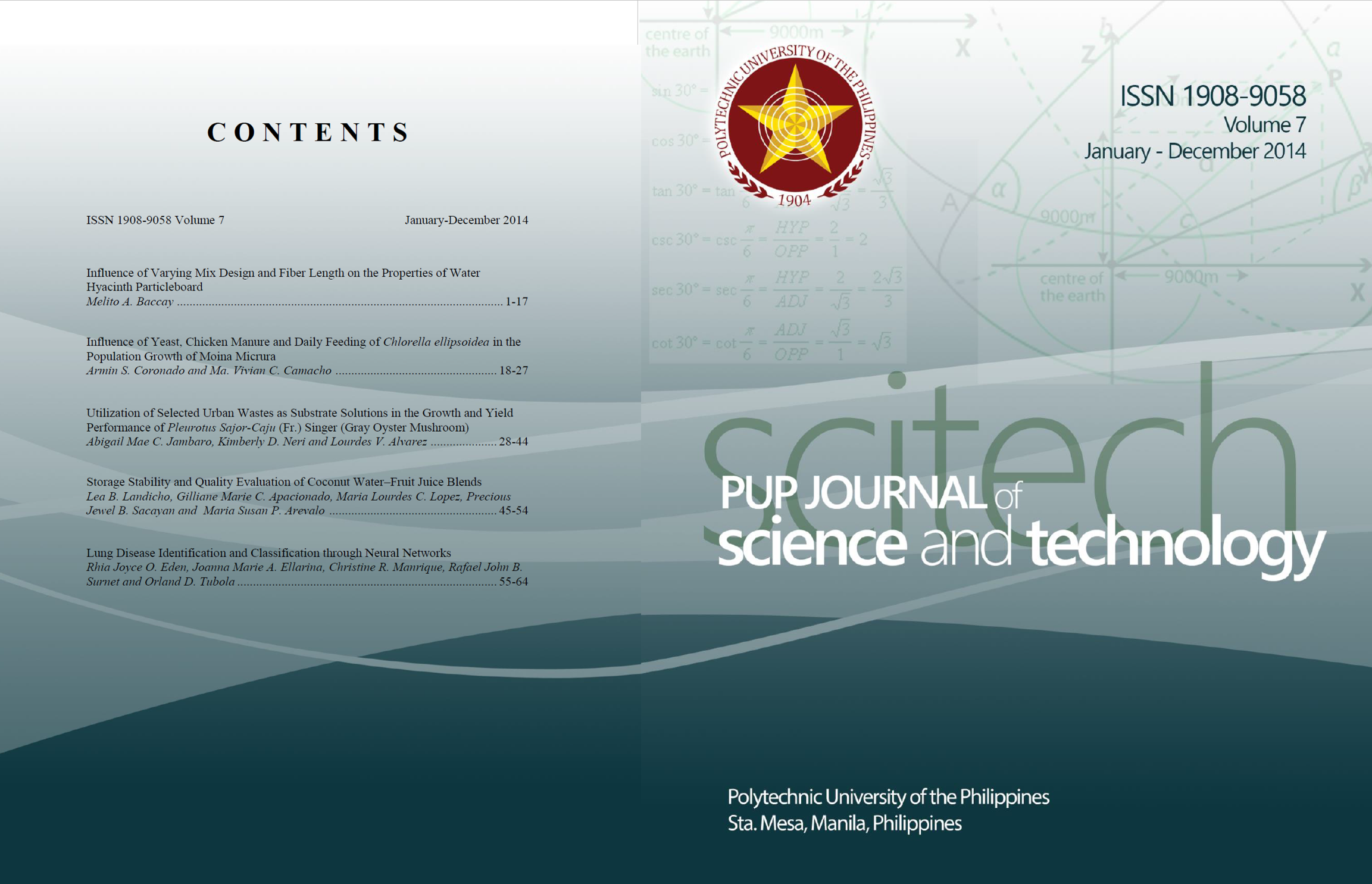Utilization of Selected Urban Wastes as Substrate Solutions in the Growth and Yield Performance of Pleurotus sajor-caju (fr.) Singer (gray oyster mushroom)
DOI:
https://doi.org/10.70922/nhsddk88Keywords:
Pleurotus sajor-caju, urban wastes, mycelial growth, yield, biologicalAbstract
Mushrooms are being cultivated worldwide for its nutritional and medicinal value. Agricultural wastes rich in lignocellulosic substances are commonly used as substrates for mushroom cultivation. Moreover, selected urban wastes that contain lignocellulosic substances are also potential substrates which when utilized can help lessen wastes in the environment. This study tested the possible utilization of selected urban wastes as solution substrates for the growth and yield performance of Pleurotus sajor-caju (Fr.) Singer. Four different urban waste substrates (banana peels, newspaper, cotton textile scraps and mixture of leaf litters) and their combinations were used in the study with sawdust which served as the control. Percentage of mycelial growth, colonization period, primordial formation, harvesting time, number of fruiting bodies, cap diameter, stalk length, total yield and size of the mushroom and biological efficiency of the substrates used were assessed to determine the effects on growth and yield. Results revealed that the substrate with 50% newspaper + 50% sawdust showed rapid colonization, fast primordial formation and earliest harvest day and obtained the highest yield of mushroom and biological efficiency. Mushrooms did not proliferate mostly in the substrates with the combinations of leaf litter, however, 25% leaf litter + 75% sawdust produced less yield of mushrooms. The least yield of mushrooms was from the substrate with 100% cotton textile scraps. Other combinations used in the study are effective substrates in cultivating P. sajor-caju, but have different average number and yield of mushrooms produced. The study demonstrated that faster mycelial growth is consistent with better yield of the mushroom and highest biological efficiency of the substrate.
Downloads
References
AMGA. 2004. The Australian Mushroom Growers Association (AMGA), Locked Bag 3, 2 Forbes St., Windsor, NSW, 2756, Australia.
Baysal, E. and H. Peker. 2001. An Alternate to Waste Paper Recycling; Mushroom Cultivation. Teknoloji 3(4):9-13.
Bisaria, R., M. Madan, and V.S. Bisaria. 1987. Biological efficiency and nutritive value of Pleurotus sajor-caju cultivated on the different agro-wastes. Biological Wastes. 19: 239-255.
Chang S.T, O.W. Lau and K.Y. Cho. 1981. The cultivation and nutritive value of Pleurotus sajor-caju. European Journal of Applied Microbiology, 12; 58-62.
Chang, S. T. and P. G. Miles. 2004. Mushrooms: cultivation, nutritional value, medicinal effect, and environmental impact (Second Edition). CRC Press. Boca Raton, 451pp.
Custodio, J.D. 2004. Mushoom growers’ handbook: substrate – coco lumber sawdust. Bataan State College, Philippines. 91-94.
Dhal, Arabinda. 2012. Odisha: Mushroom farming popular near Paradip. The Hindu Business line newspaper.
Gibriel, A.Y. et. al. 1996. Cultivation of oyster mushrooms (Pleurotus spp.) evaluations of different media and organic substrates. Faculty of Agriculture, Ain-Shans University, Shobra-Khaima, Cairo, Egypt. 415-421.
Hanko, Johanne. 2001. Mushroom cultivation for people with disabilities – a training manual. Food and Agriculture Organization of the United Nations.
Khan, A.M., S.M. Khan and A.S. Shakir. 2001. Studies on the cultivation of the oyster mushroom on different substrates. Pakistan Journal of Phytopathology, 13:
140-143.
Kurt S. and S. Buyukalaca. 2010. Yield Performances changes in enzyme activities of Pleurotus spp. (P. ostreatus and P. sajor-caju) cultivated on different agricultural wastes. Bioresource Technology, 101: 3164-3169.
Narain R., R.K. Sahu, S. Kumar, S.K. Garg, C.S. Singh and R.S. Kanaujia. 2008. Influence of different nitrogen rich supplements during cultivation of Pleurotus florida on maize cobs substrate. Environmentalist. 29:1–7.
Oei, Peter. 2005. Small-scale mushroom cultivation. Agromisa Foundation and CTA, Netherlands. 9-12.
Onyango B.O., V.A. Palapala, P.F. Arama, S.O. Wagai and B.M. Gichumu. 2011. Sustainability of selected supplemented substrates for cultivation of Kenyan native wood ear mushrooms (Auricularia auricula). American Journal of Food Technology, 6:395–403.
Panjabrao M.V., P.S. Sopanrao, S.A. Ahmed, B.M.M. Vaseem. Bioconversion of low quality lignocellulosic agricultural waste into edible protein by Pleurotus sajor-caju (Fr.) Singer. J. Zhejiang Univ-SC A. 2007; 8:745–751. [PMC free article] [PubMed]
Pathak, N.C. and R. Goel. 1988. Perspectives in Mycology and Plant Pathology. Pp. 103-122. Malhotra Publishing House. New Delhi, India.
Pokhrel C.P., R.K.P.Yadav, S. Ohga. 2009. Effects of physical factors and synthetic media on mycelial growth of Lyophyllum decastes. Journal of Ecobiotechnology, 1: 46.
Pokhrel, C.P., N. Kalyan, U. Budathoki, and R.K.P. Yadav. 2013. Cultivation of Pleurotus sajor-caju using different agricultural residues. International Journal of Agricultural Policy and Research, 1 (2), 19-23.
Rajapakse, P. 2011. New Cultivation Technology for Paddy Straw Mushroom (Volvariella volvacea). Proceedings of the 7th International Conference on Mushroom Biology and Mushroom Products (ICMBMP7) 2011
Royes, D.J. 2002. Influence of spawn rate and commercial delayed release nutrient levels on Pleurotus cornucopiae (oyster mushroom) yield, size and time production. Applied Microbiology and Biotechnology, 58:527-531.
Shah. Z.A, M. Ashraf and M.I. Ch. 2004. Comparative study on cultivation and yield performance of oyster mushroom on different substrates. Pakistan Journal of Nutrition, 3(3):158-160.
Shen, Q., and D.J. Royse. 2001. Effects of Nutrient Supplements on Biological Efficiency, Quality and Crop Cycle Time of Mistake (Grifola frondosa). Applied Microbiology Biotechnology, 57: 74-78.
Vyas, N.L., M. Singh, S.P. Joshi. 2003. Evaluation of locally available plant materials for production of oyster mushroom (Pleurotus florida) in arid region of India. Journal of Ecophysiology, 6 (1/2):41-43.
Zadrazil F. 1980. Influence of ammonia nitrate and organic supplements on the yield of Pleurotus sajor-caju (Fr.) Singer. European Journal of Applied Microbiology and Biotechnology, 9:31-35.
Downloads
Published
Issue
Section
License
Copyright (c) 2015 PUP Journal of Science and Technology

This work is licensed under a Creative Commons Attribution-NonCommercial 4.0 International License.







